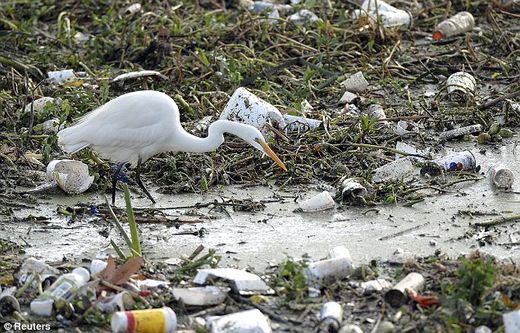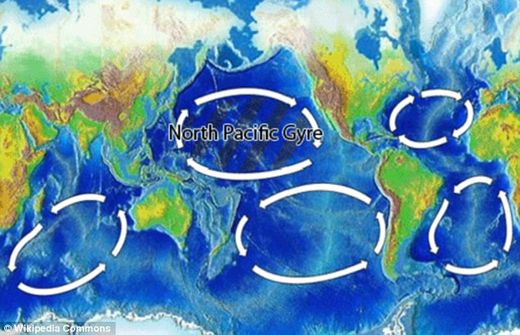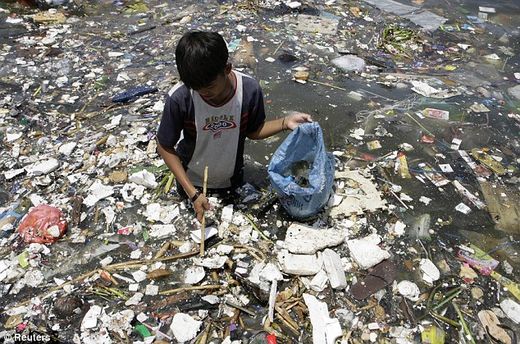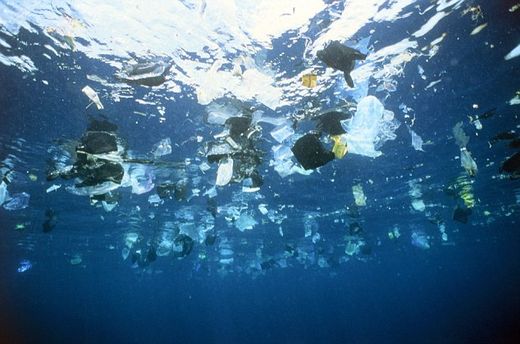
© Reuters
Scientists have found that the massive swirl of plastic waste known as the 'Great Pacific Garbage Patch' has increased a hundredfold since the early 1970s, which could spell major changes for California and other coastal states.
During a 2009 expedition, the Scripps Institution of Oceanography researchers took water samples 1,000 miles west of California, and then compared the amount of plastic they detected with samples dating back to 1972.
While many of the samples taken 40 years ago included little or no plastic, vast stretches of the North Pacific are now polluted with billions of tiny pieces of confetti-like trash that come from flotsam and jetsam that is swept into the North Pacific Subtropical Convergence Zone by circulating ocean currents known as a gyre, and is then broken down by winds and waves.
The particles of 'microplastic' - pieces of plastic smaller than 5 milometer in diameter - sit on or near the surface, where they are consumed by fish, sea turtles and other marine animals.
The latest samples show that the garbage patch - which is about the size of Texas - has become much denser: There are roughly 100 times more pieces of plastic per cubic meter of water than were in samples during the 1970s, according to the study cited by the
San Jose Mercury News.
'We were really surprised. It is a very large increase,' said Miriam Goldstein, a Ph.D. graduate student in biological oceanography and lead author of the study.

© Wikipedia Commons
The study, which appeared on Wednesday's online editions of the journal Biology Letters, also found the floating debris makes it easier for the marine insect known as a 'water strider' or 'sea skater'to lay its eggs out over the ocean - a fact that could have negative consequences for other animals.
The bugs - relatives of pond water skaters - normally lay eggs on pieces of wood, feathers, seashells and tar lumps, but now they are taking advantage of the abundant supply of plastic.
Since the insects subsist on zooplankton and fish larvae, an explosion in their population could lead to a reduced food supply for other animals, including fish and turtles, which eat the same prey. More bugs also could mean more food for their predators.
This latest study comes on the heels of an earlier research conducted last year by Scripps scientists that showed 9 per cent of fish collected on the expedition to the 'Pacific Garbage Patch' in 2009 -- nearly 1 in 10 -- had plastic in their stomachs.
That investigation, published in
Marine Ecology Progress Series, estimated that the fish at intermediate ocean depths in the North Pacific Ocean could be ingesting plastic at a rate of roughly 12,000 to 24,000 tons a year, according to
BBC News.
Goldstein said that since cleaning up the all plastic trash in the ocean is virtually impossible, prevention is the goal.
'Once a piece of plastic is in the ocean, it is really hard and expensive to get it out again,' she said.
'Historically, we have not been very good at stopping plastic from getting into the ocean, so hopefully in the future we can do better,' Goldstein added.

© Reuters
The alarming findings come less than a month after University of Washington oceanographer Giora Proskurowski reported that there is far more plastic in the world's oceans than previously thought.
Proskurowski said that during a research cruise in the Pacific Ocean, he noticed that the surface of the water was littered with tiny specs of plastic, which vanished from sight when the wind suddenly picked up.
Taking water samples from 16 feet, he discovered the wind was pushing the lightweight plastic particles below the surface.
Data collected from just the surface of the water commonly underestimates the total amount of plastic in the water by an average factor of 2.5, according to further research from Proskurowski and his team.
In high winds, the volume of plastic trash could be underestimated by a factor of 27, he reported with Tobias Kukulka, of the University of Delaware, in the journal Geophysical Research Letters.

© n/a
It is expected that as a result of the new findings, there will be more calls for cities and states to ban plastic bags and Styrofoam packaging. In California, 14 billion plastic bags are distributed annually, and only 3 per cent are recycled.
In 2010, the state Senate voted 21-14 to defeat a bill that would have banned plastic bags from being given out at grocery stores and other retailers, after heavy lobbying and donations from the American Chemistry Council and the plastics industry.
Since then, cities and counties have been passing their own bans.
As of this week, 45 California cities and counties including San Francisco, San Jose and Oakland have banned plastic bags in stores. Meanwhile, more than 60 California cities and counties have restricted or banned Styrofoam.
Because about 80 per cent of the trash in the Pacific Ocean comes from land, the alarming findings of this week's study illustrate a need for a change in behaviour, said Kaitilin Gaffney, Pacific program director of the Ocean Conservancy, an environmental group.
'This is a problem created by personal action, and frankly, personal carelessness. Ultimately, we need a behaviour shift,' she said.
'When I was a kid, everybody smoked. Now, most people don't smoke. The solution, really, is to move away from single-use items, and we need people to basically be more thoughtful,' Gaffney added.
Reader Comments
to our Newsletter